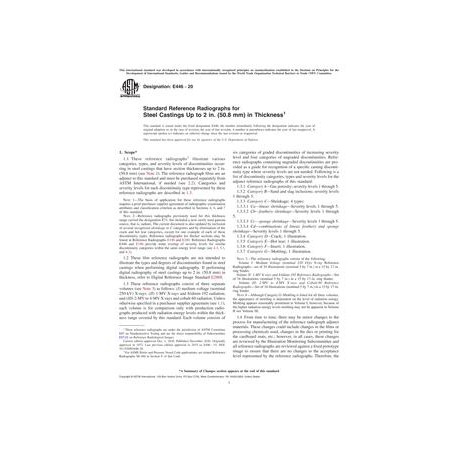No products
 View larger
View larger ASTM E446-20
M00000555
New product
ASTM E446-20 Standard Reference Radiographs for Steel Castings Up to 2 in. (50.8 mm) in Thickness
standard by ASTM International, 12/01/2020
In stock
More info
Full Description
1.1''These reference radiographs2 illustrate various categories, types, and severity levels of discontinuities occurring in steel castings that have section thicknesses up to 2 in. (50.8 mm) (see Note 2). The reference radiograph films are an adjunct to this standard and must be purchased separately from ASTM International, if needed (see 2.2). Categories and severity levels for each discontinuity type represented by these reference radiographs are described in 1.3.
Note 1:''The basis of application for these reference radiographs requires a prior purchaser supplier agreement of radiographic examination attributes and classification criterion as described in Sections 4, 6, and 7 of this standard.
Note 2:''Reference radiographs previously used for this thickness range carried the designation E71, but included a now rarely used gamma source, that is, radium. The current document is also updated by inclusion of several recognized shrinkage or C categories and by elimination of the crack and hot tear categories, except for one example of each of these discontinuity types. Reference radiographs for thicker sections may be found in Reference Radiographs E186 and E280. Reference Radiographs E446 and E186 provide some overlap of severity levels for similar discontinuity categories within the same energy level range (see 4.3, 5.1, and 6.3).
1.2''These film reference radiographs are not intended to illustrate the types and degrees of discontinuities found in steel castings when performing digital radiography. If performing digital radiography of steel castings up to 2 in. (50.8 mm) in thickness, refer to Digital Reference Image Standard E2868.
1.3''These reference radiographs consist of three separate volumes (see Note 3) as follows: (I) medium voltage (nominal 250-kV) X-rays. (II) 1-MV X-rays and Iridium-192 radiation, and (III) 2-MV to 4-MV X-rays and cobalt-60 radiation. Unless otherwise specified in a purchaser supplier agreement (see 1.1), each volume is for comparison only with production radiographs produced with radiation energy levels within the thickness range covered by this standard. Each volume consists of six categories of graded discontinuities of increasing severity level and four categories of ungraded discontinuities. Reference radiographs containing ungraded discontinuities are provided as a guide for recognition of a specific casting discontinuity type where severity levels are not needed. Following is a list of discontinuity categories, types and severity levels for the adjunct reference radiographs of this standard:
1.3.1''Category A'''Gas porosity; severity levels 1 through 5.
1.3.2''Category B'''Sand and slag inclusions; severity levels 1 through 5.
1.3.3''Category C'''Shrinkage; 4 types:
1.3.3.1''Ca'''linear shrinkage'''Severity levels 1 through 5.
1.3.3.2''Cb'''feathery shrinkage'''Severity levels 1 through 5.
1.3.3.3''Cc'''sponge shrinkage'''Severity levels 1 through 5.
1.3.3.4''Cd'''combinations of linear, feathery and sponge shrinkage'''Severity levels 1 through 5.
1.3.4''Category D'''Crack; 1 illustration.
1.3.5''Category E'''Hot tear; 1 illustration.
1.3.6''Category F'''Insert; 1 illustration.
1.3.7''Category G'''Mottling; 1 illustration.
Note 3:''The reference radiographs consist of the following:
''' Volume I: Medium Voltage (nominal 250 kVp) X-ray Reference Radiographs'''set of 34 illustrations (nominal 5 by 7 in.) in a 15 by 17-in. ring binder.
'''Volume II: 1-MV X-rays and Iridium-192 Reference Radiographs'''Set of 34 illustrations (nominal 5 by 7 in.) in a 15 by 17-in. ring binder.
''' Volume III: 2-MV to 4-MV X-rays and Cobalt-60 Reference Radiographs'''Set of 34 illustrations (nominal 5 by 7 in.) in a 15 by 17-in. ring binder.
Note 4:''Although Category G'''Mottling is listed for all three volumes, the appearance of mottling is dependent on the level of radiation energy. Mottling appears reasonably prominent in Volume I; however, because of the higher radiation energy levels mottling may not be apparent in Volume II nor Volume III.
1.4''From time to time, there may be minor changes to the process for manufacturing of the reference radiograph adjunct materials. These changes could include changes in the films or processing chemicals used, changes in the dies or printing for the cardboard mats, etc.; however, in all cases, these changes are reviewed by the Illustration Monitoring Subcommittee and all reference radiographs are reviewed against a fixed prototype image to ensure that there are no changes to the acceptance level represented by the reference radiographs. Therefore, the adjunct reference radiographs remain valid for use with this standard regardless of the date of production or the revision level of the text standard.
1.5''Units'''The values stated in inch-pound units are to be regarded as standard. The values given in parentheses are mathematical conversions to SI units that are provided for information only and are not considered standard.
1.6''This standard does not purport to address all of the safety concerns, if any, associated with its use. It is the responsibility of the user of this standard to establish appropriate safety, health, and environmental practices and determine the applicability of regulatory limitations prior to use.
1.7''This international standard was developed in accordance with internationally recognized principles on standardization established in the Decision on Principles for the Development of International Standards, Guides and Recommendations issued by the World Trade Organization Technical Barriers to Trade (TBT) Committee.

